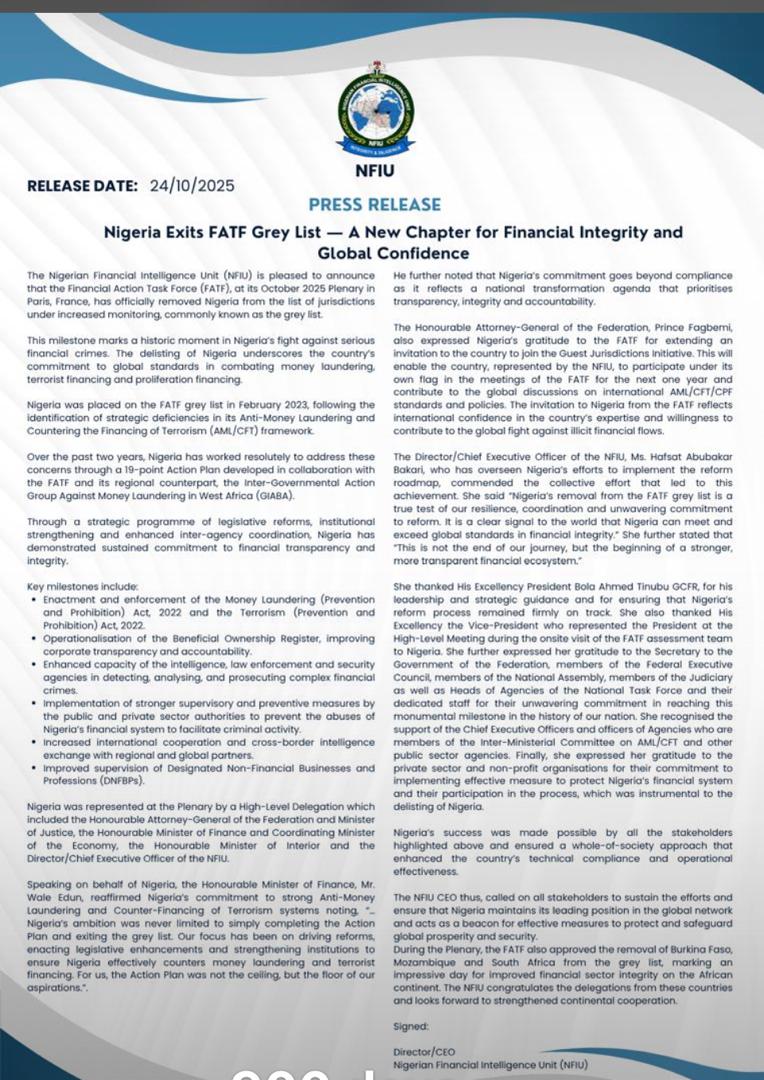The Financial Action Task Force (FATF), the global body responsible for combating money laundering and terrorist financing, announced on Friday that it has removed Nigeria from its grey list after nearly three years, signaling renewed confidence in Africa’s 4th-largest economy and its financial system.
Nigeria was delisted alongside South Africa, Burkina Faso, and Mozambique, following what FATF described as “significant progress” by the countries in strengthening anti-money laundering (AML) and counter-terrorism financing (CFT) systems. Nigeria and South Africa were added to the grey list in February 2023, Mozambique in October 2022, and Burkina Faso in February 2021.

The decision comes after an on-site assessment confirmed that Nigeria had implemented substantial reforms to address strategic deficiencies identified by the FATF in previous reviews. The global watchdog praised the country’s “sustained political commitment and measurable progress” in improving transparency, monitoring illicit financial flows, and enforcing compliance within its banking and non-banking sectors.
A Turning Point for Nigeria’s Financial System
Nigeria’s removal from the grey list is widely viewed as a crucial step toward restoring investor confidence, reducing transaction costs, and improving the ease of doing business across borders.
Being on the list had complicated Nigeria’s international transactions, as foreign banks and financial institutions imposed heightened due diligence measures, increasing compliance costs for businesses and individuals. The development had also hindered capital inflows, restricted correspondent banking relationships, and slowed foreign direct investment (FDI).
With Friday’s announcement, Nigeria can expect smoother cross-border transactions, faster processing of remittances, and lower compliance costs for international businesses. The country receives around $20 billion in remittances annually, and reducing compliance barriers could boost inflows through formal channels.
Finance Minister Wale Edun welcomed the news, describing it as “a vote of confidence in Nigeria’s reform trajectory.”
“This development reinforces confidence in our economy and the integrity of our monetary and financial systems, signaling to investors and global partners that Nigeria’s institutions are strong, transparent, and internationally trusted,” Edun said in a statement.
“It will ease cross-border transactions, improve capital flows, including foreign direct investment, and strengthen the foundations for rapid and sustainable economic growth and job creation,” he added.
A Long Road to Reform
Nigeria’s removal from the FATF grey list follows a sustained campaign led by the Nigerian Financial Intelligence Unit (NFIU), the Central Bank of Nigeria (CBN), and other regulatory agencies to overhaul compliance and enforcement mechanisms.
Earlier this year, NFIU Chief Executive Officer Hafsat Bakari had projected that Nigeria could exit the list by late 2025, following the approval of the country’s fifth progress report by the FATF. The report, she said, reflected “Nigeria’s concrete and measurable progress in strengthening its AML/CFT framework.”
Bakari emphasized that the approval of the fifth progress report was “a substantial achievement that demonstrates Nigeria’s adherence to international standards and commitment to a more transparent financial environment.”
Over the past two years, Nigerian authorities have tightened oversight of banks, fintechs, and designated non-financial businesses such as real estate agents and casinos. The country has also expanded cooperation between the NFIU, the Economic and Financial Crimes Commission (EFCC), and international partners to track illicit capital flows.
The FATF decision is expected to improve Nigeria’s global financial standing, potentially lowering the country’s risk profile among lenders and boosting the naira through renewed capital inflows. Economists say it could also strengthen the Tinubu administration’s ongoing fiscal and monetary reforms aimed at stabilizing the economy and attracting foreign investment.
Nigeria’s improved compliance rating may particularly benefit sectors that have struggled to attract foreign capital due to reputational concerns, including energy, manufacturing, and financial technology.
Since 2023, the Nigerian government has been working to rebuild confidence in the economy through structural reforms. These include efforts to unify the exchange rate, remove fuel subsidies, and modernize the tax and customs systems.
Analysts believe the FATF delisting could provide a psychological lift for investors and development partners who have been waiting for signs of policy stability and stronger governance.
For Nigeria, the exit from the grey list not only marks the end of a challenging chapter but also a renewed opportunity to position itself as a credible financial hub in Africa.






